- University of Lincoln, School of Mathematics and Physics, Lincoln, United Kingdom
We perform simulations of the
Introduction
In 2007 the active young solar mass star J1407, also known as V1400 Centauri, was observed to have an unusually long and complex transit of
Photometric studies after 2007 by the five ground-based telescopes All Sky Automated Survey (ASAN; Pojmanski (1997)) All Sky Automated Survey for Supernovae (ASAN-SN; Kochanek et al. (2017)), Kilodegree Extremely Little Telescope (KELT; Pepper et al. (2007); Pepper et al. (2012)), The Panchromatic Robotic Optical Monitoring and Polarimetry Telescopes (PROMPT; Reichart et al., 2005), Remote Observatory Atacama Desert (ROAD; Hambsch (2012)) and The Transiting Exoplanet Survey Satellite (TESS; Ricker et al. (2015)) revealed an activity cycle of 5.4 years for J1407, but no transiting companions or further deep transits associated with a ring system (Barmentloo et al., 2021).
A period of
The Hill radius is then a function of the semi-major axis (
Like Saturn’s ring, J1407b’s ring is not radially uniform; instead, there are hints of an unseen exomoon in the form of gaps; or regions with relatively low surface densities. Three possible mechanisms can form a gap in a planetary ring: The first is due to Mean Motion Resonances (MMR) by moons external to the ring and is analogous to how Mimas causes the Cassini Division in Saturn’s rings (Goldreich and Tremaine 1978; Noyelles et al., 2016). However, models of moons placed at various MMR’s around J1407b’s ring showed this was not possible without causing significant disruption to the outer region of the ring edge (Sutton 2019). Secondly, moons embedded within the ring can carve out a gap proportional to their Hill radius. Saturn’s small moons Pan and Daphnis clear out gaps in the ring with a width related to their Hill radius
If moons are present around gas giants, typical timescales for in-situ formation in a gaseous circumplanetary disk ranges from
It is worth noting that the orbital architecture of Saturn, Uranus and Neptune’s regular moons suggest an alternative formation mechanism than those of the larger Galilean moons of Jupiter. Here, the masses of the satellites increase with increasing distance from the planets Roche limit. A viscously spreading ring will accrete moons once it exceeds the Roche limit, with moons being repelled outwards by angular momentum exchange with the disk (Crida and Charnoz, 2012). As the ring becomes depleted, the mass of the subsequent moons and migration rate decrease.Where J1407b is on a highly eccentric orbit about the primary, the potential presence of exomoons forming gaps is still unanswered. The location of the ring outside the Roche limit suggests a favourable environment for accretion of ring material into moons, but this does not consider the close passage at periapsis, which is likely to impact moon formation. While Saturn’s F ring is in a different tidal environment, it lies very close to the Roche Limit for water ice and is perturbed by the nearby moons Prometheus and Pandora. Yet, observations and models (Beurle et al., 2010; Sutton 2018) suggest moonlets can still form due to localised gravitational instabilities. Therefore, this does not rule out the formation of moons within a strongly perturbed ring.
Methods
We use the same ring model as used by Sutton (2019), which placed 10,000 particles around the exoplanet J1407b. Ring particles are distributed in the radial direction between
The primary star, J1407 (V1400 Centauri), is placed at the origin with a mass of
Numerical integration is carried out using Gadget-2 (Springel 2005), which uses a hierarchical multipole expansion to deal with gravitational interactions between particles in the form of a tree-walk to improve computational costs. Timesteps of particles are variable and scale with acceleration
Here,
Particles with radial distance
Previous work by Kenworthy and Rieder (2016) showed that both a prograde and retrograde ring system would lose the particles from outer region due to strong gravitational perturbations, which we also observed in our models. Consequently, ring particles with radial distances
Prograde Ring
A prograde ring around J1407b is first considered, which is expected to be less stable during close passes at its pericenter, as reported by Rieder and Kenworthy (2016). Figure 1 shows the first orbit of the prograde ring, where it starts at the apocentre. As expected, increasing the eccentricity also increases the loss of ring particles, with the
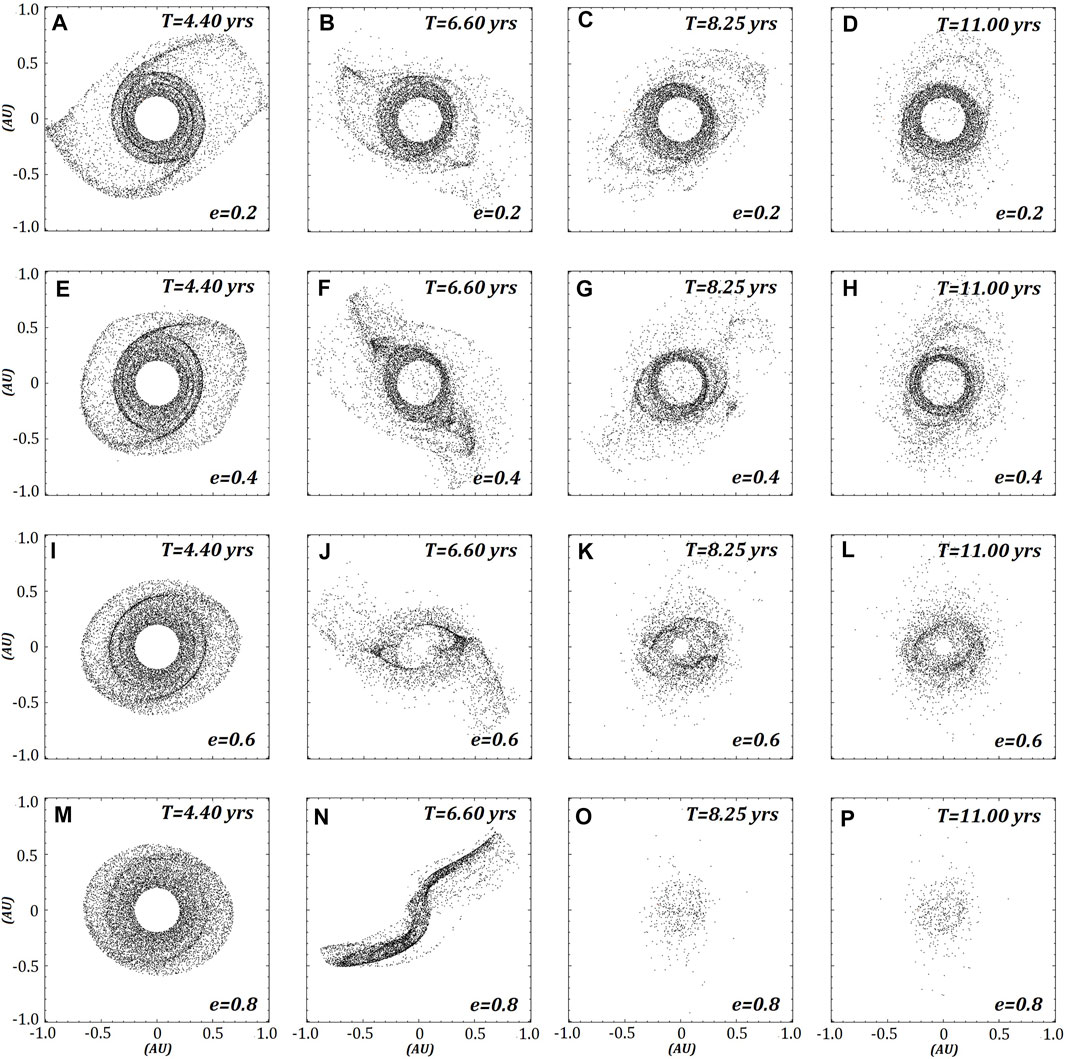
FIGURE 1. Four models of a ring around J1407b
Rendered plots of the surface density (Figure 2) show some models experience a short-term increase in local surface density. The lower eccentricity models (
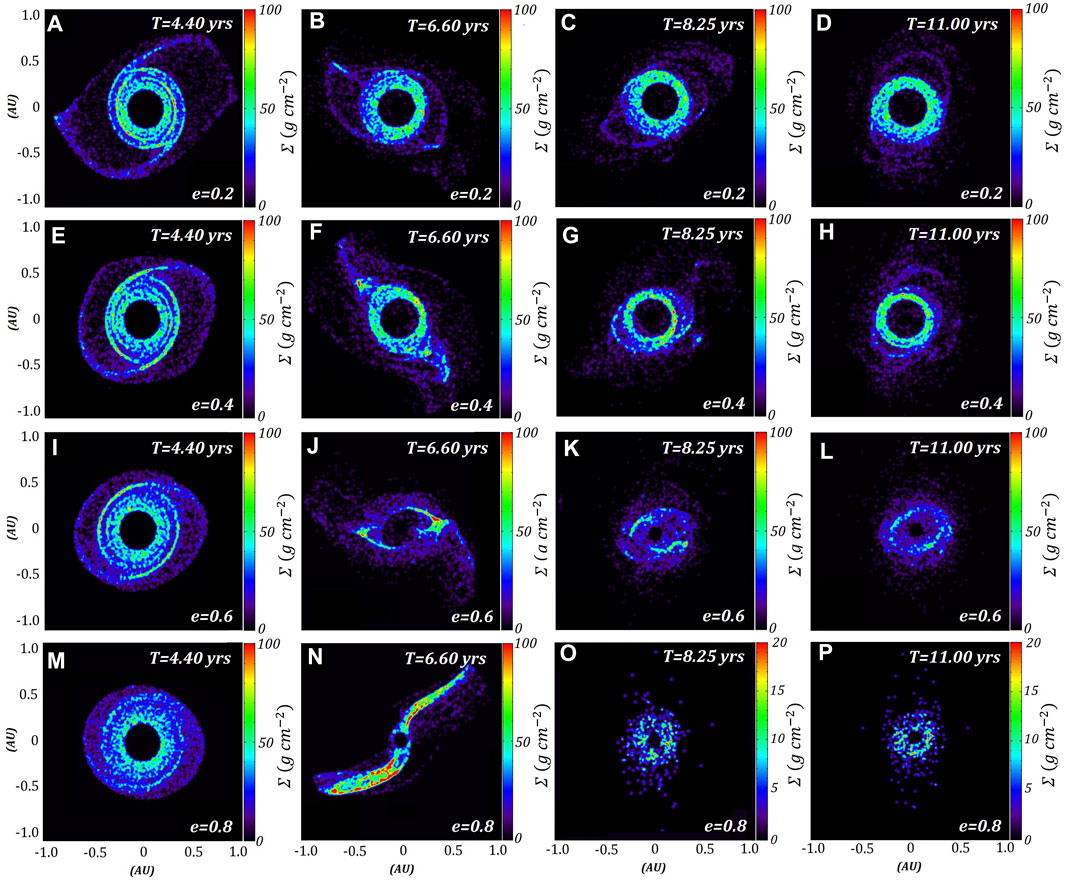
FIGURE 2. Surface densities of the same four models in Figure 1. The x and y axes represent the instanteous positions of ring particles around J1407b, which is at the origin. The rows represent each model, where
Retrograde Ring
Particles are placed in the same ring around J1407b but with retrograde velocities in respect to the orbit of J1407b. Rieder and Kenworthy (2016) identified that a retrograde ring would be more stable against strong perturbations caused by close passes to the primary due to a highly eccentric orbit. Therefore, a large proportion of the ring remains bound to J1407b for all eccentricities beyond one complete orbit (Figure 3) compared with a prograde ring (Figure 1). Evidence of spiral arm wave structures can be seen after the first orbital period, noted by their higher surface densities (Figure 4), which persist for multiple orbits of the low eccentricity models (
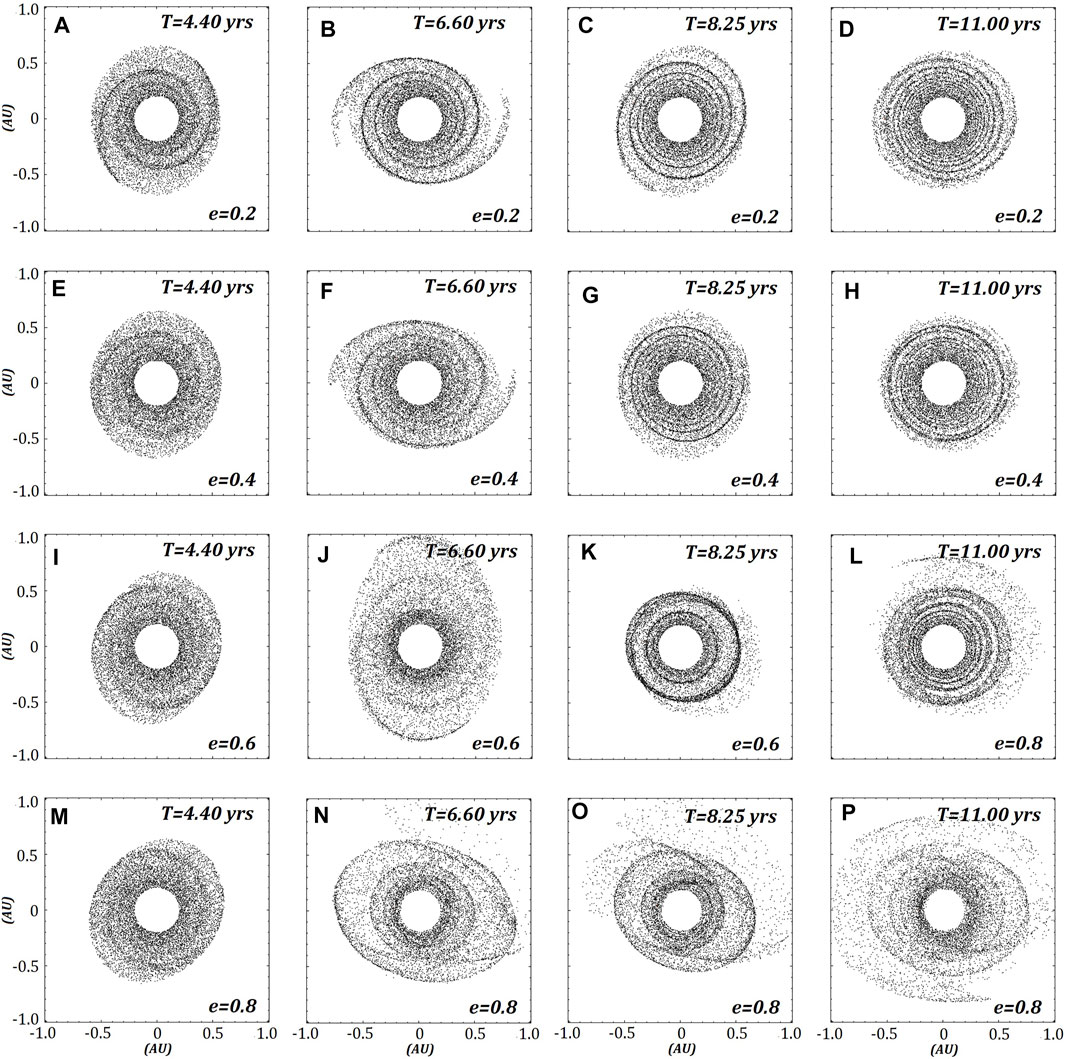
FIGURE 3. Four models of a retrograde ring around J1407b
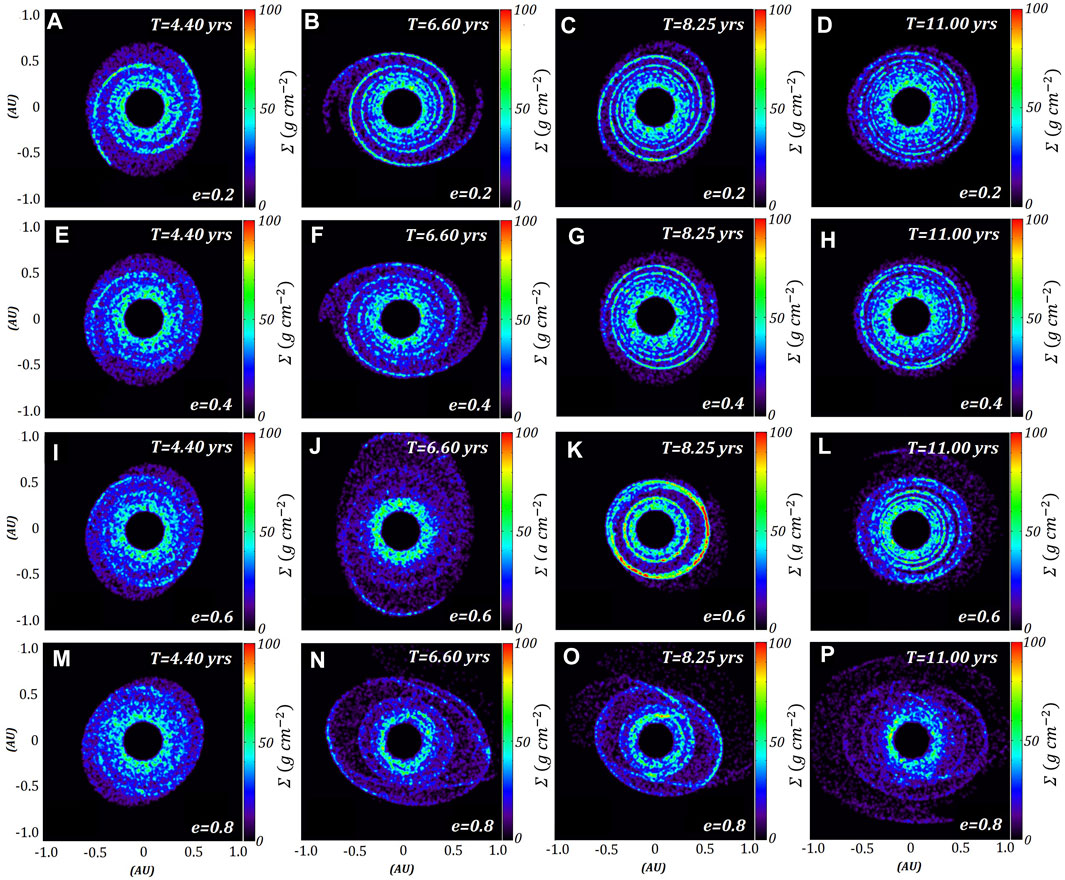
FIGURE 4. Surface densities of the same four models as Figure 3. The x and y axes represent the instanteous positions of ring particles around J1407b, which is at the origin. The rows represent each model, where
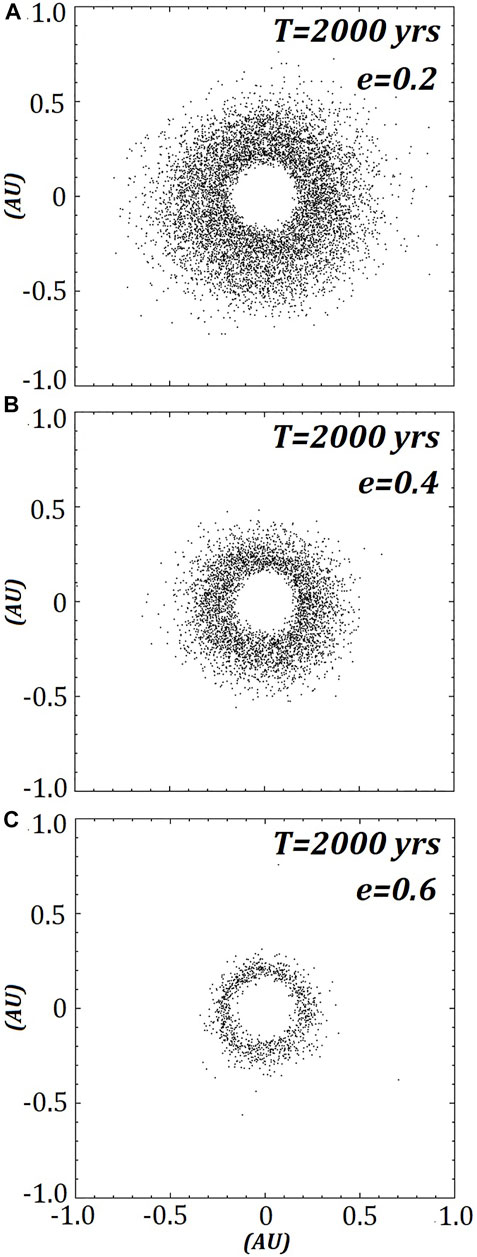
FIGURE 5. The three remaining models A) e = 0.2, B) e = 0.4 and C) e = 0.6 of a retrograde ring around J1407b (M = 20MJ) after 2000 years or ∼182 complete orbits about the primary.
Figure 6 shows total number of particles in each of the retrograde ring models over 2000yrs and is sampled at 100 years intervals. The remaining three models begin to plateau towards the 2000 year mark but still show a mass loss of
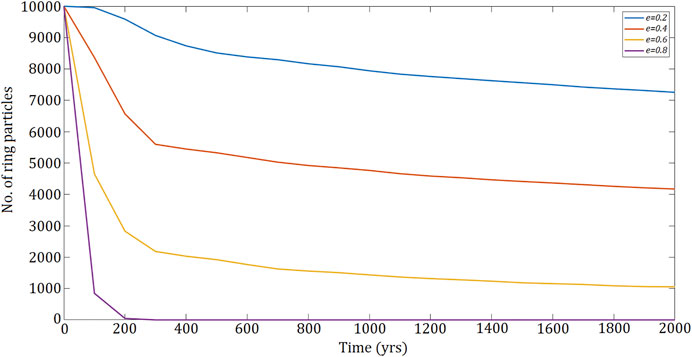
FIGURE 6. The number of particles in all 4 retrograde ring models is plotting against time and shows that the majority of particles lost occurs within ∼300 yrs.
Radial Profile
A key observation of the original transit suggested a gap in the ring could be indirect evidence of an exomoon. However, where J1407b is on an eccentric orbit, the radial profile of the ring can have regions of higher and lower density without the need for a moon. Here, we create radial profiles of the azimuthally averaged surface density to investigate features that could be interpreted as a gap.
Predictably, the surface density of the prograde ring (Figure 7) decreases significantly as eccentricity increases, with the lower eccentricity models having most of the mass shift inwards into a narrower ring. The spiral arms observed in the retrograde ring are evident in the radial profile (Figure 8), with alternating high and lower densities. An interesting feature in one of the retrograde models,
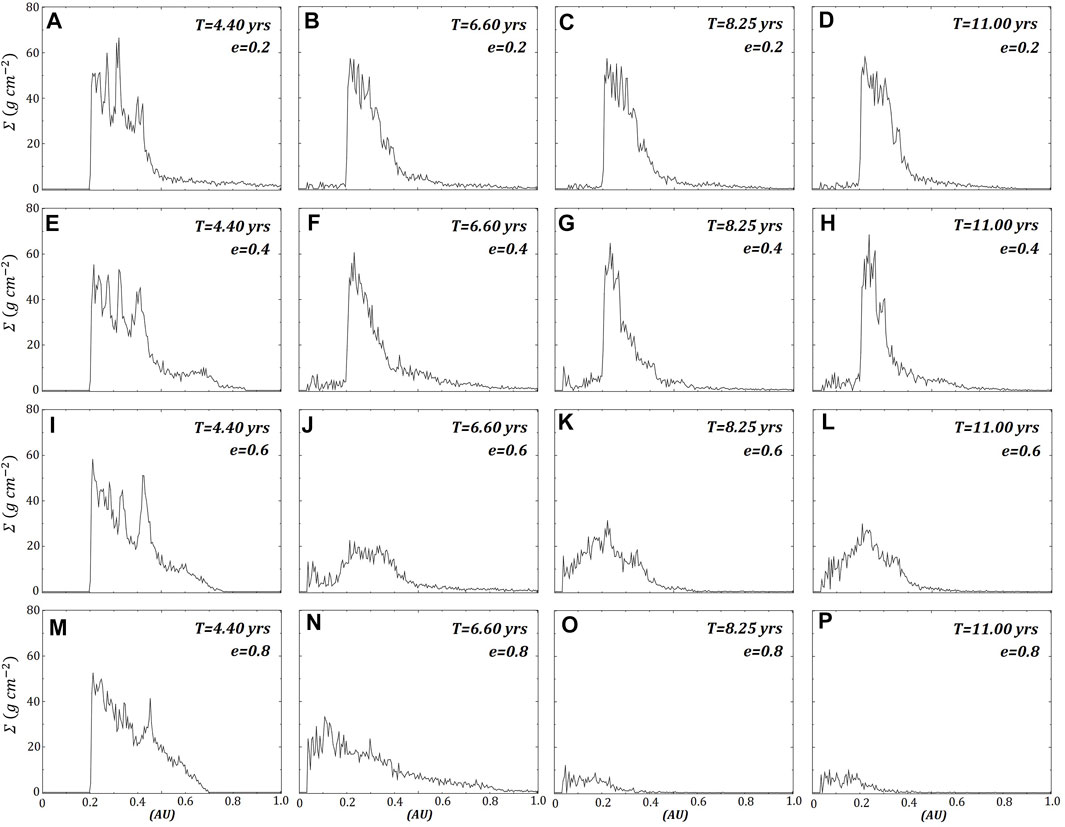
FIGURE 7. The same four prograde ring models shown in Figure 1 with their azimuthally averaged surface densities. The rows represent each model, where
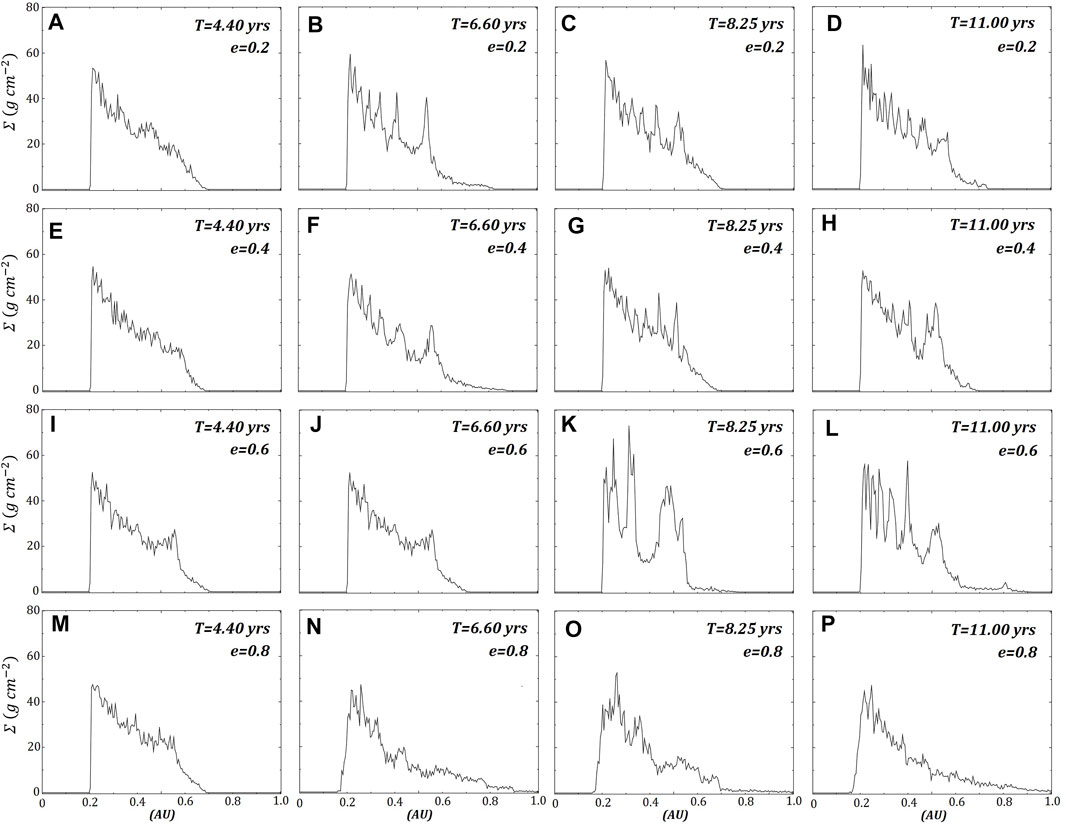
FIGURE 8. The same four retrograde ring models shown in Figure 3 with their azimuthally averaged surface densities. The rows represent each model, where
The surface density of the models that survive for 2000 years (
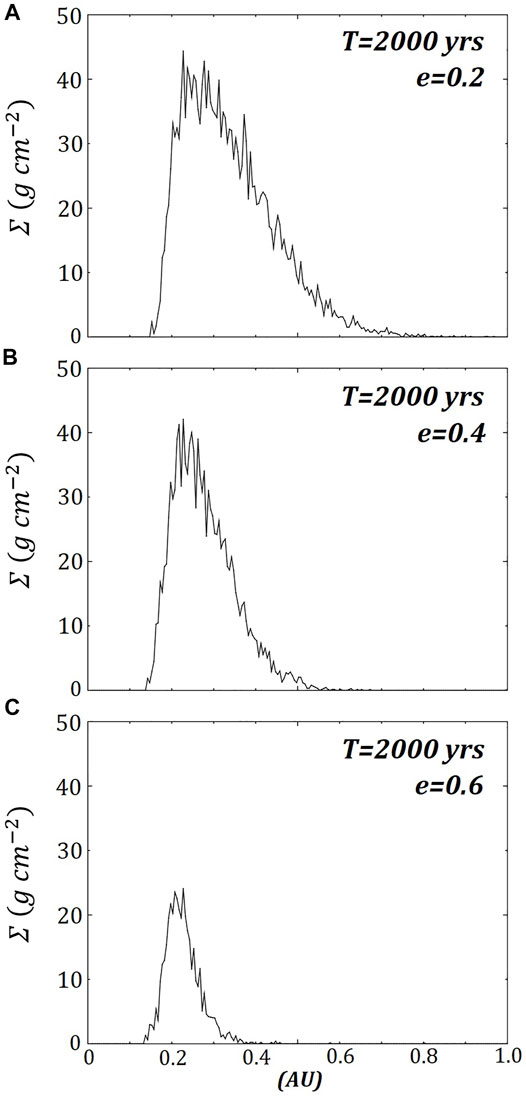
FIGURE 9. The same three retrograde ring models (A) e = 0.2, (B) e = 0.4 and (C) e = 0.6 are shown in Figure 5 with their azimuthally averaged surface densities after 2000 years or ∼182 complete orbits about the primary.
Eccentricity
We calculate the eccentricity by taking the eccentricity vector
All models show signs of excitation of eccentricity from the close passage at periapsis, with the prograde ring showing significant excitation of eccentricities (Figure 10) compared to the retrograde ring (Figure 11). The majority of excitation occurs during the first passage, with eccentricities only increasing each passage. After 2000 years, the three surviving retrograde rings all have significant eccentricities (Figure 12), including those particles located on the inner region of the ring.
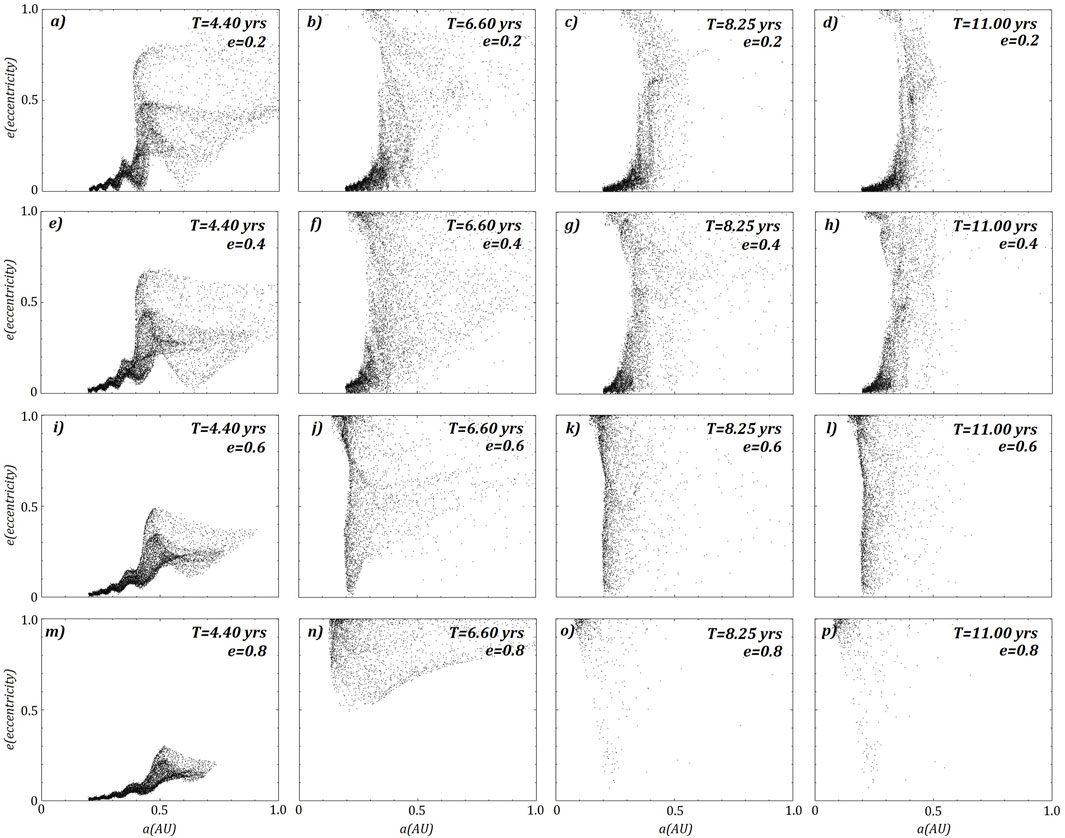
FIGURE 10. The same four prograde ring models shown in Figure 1. Here the calculated eccentricities and semi-major axis for all ring particles are plotted. The rows represent each model, where
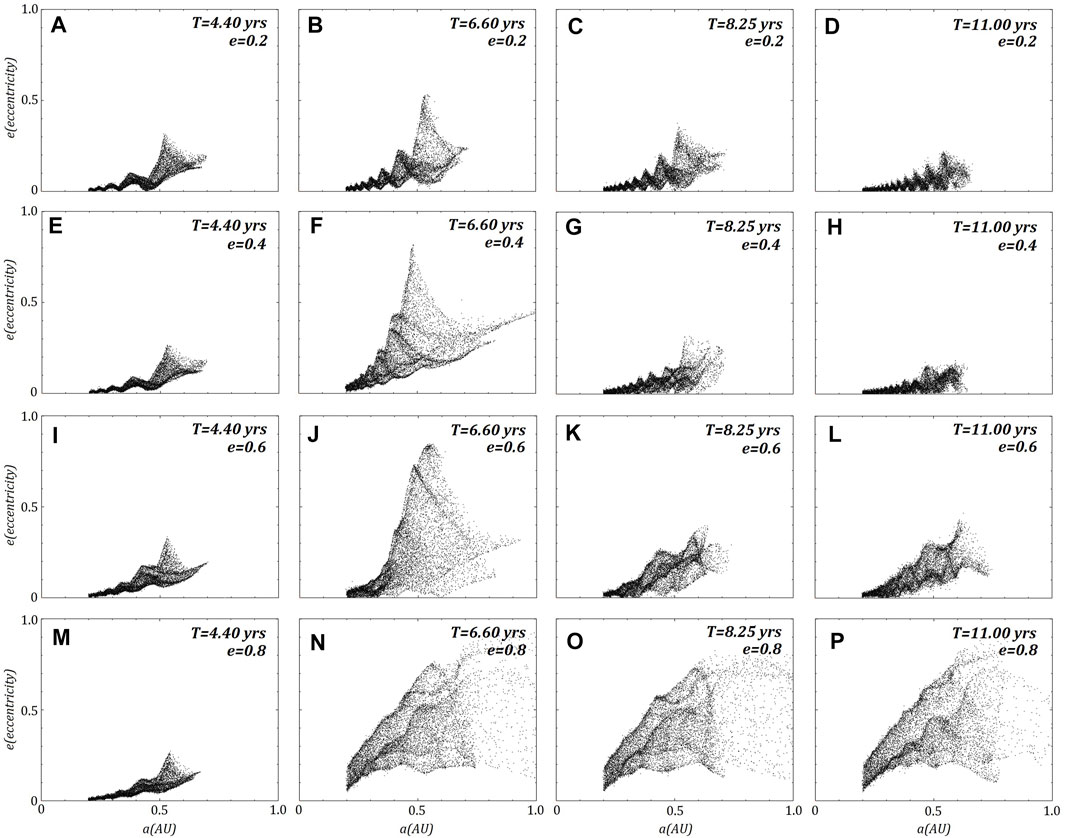
FIGURE 11. The same four retrograde ring models shown in Figure 2. Here the calculated eccentricities and semi-major axis for all ring particles are plotted. The rows represent each model, where
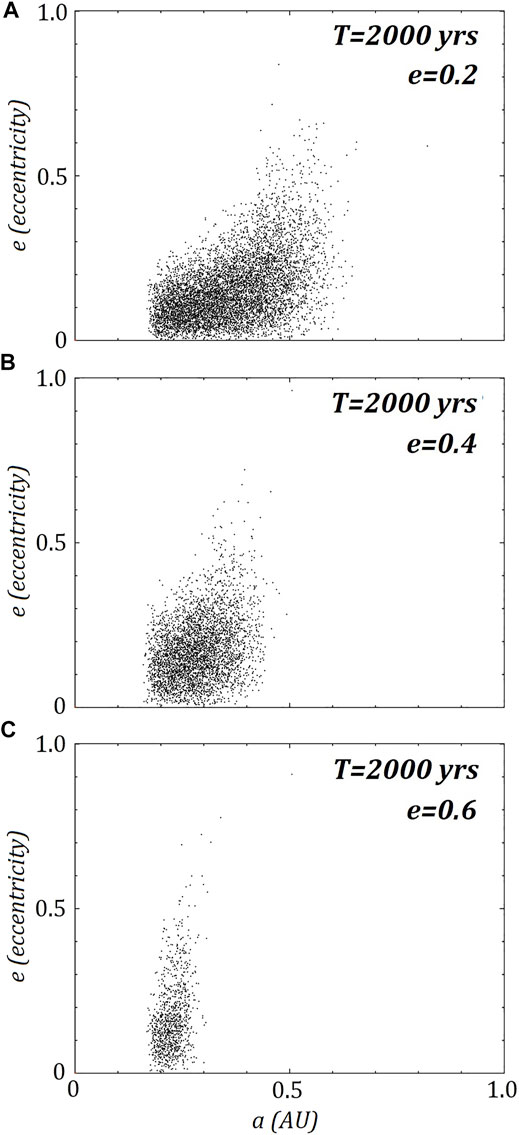
FIGURE 12. he same three retrograde ring models (A) e = 0.2, (B) e = 0.4 and (C) e = 0.6 are shown in Figure 5 with their calculated eccentricities and semi-major axis for all ring particles after 2000 years or ∼182 orbits about the primary.
It should be noted that eccentricities would be dampened where collisions between ring particles are considered, which are neglected in our models. In a non-perturbed planetary ring, particle collisions dampen individual particle’s eccentricities by introducing a viscosity (Daisaka et al., 2001). Collision frequency between particles in a ring can be given as
Discussion
Although our models agree with the retrograde scenario as the best solution for the long-term stability of a ring system, the lower mass of J1407b (
Research on the dynamic evolution of a debris disk around Saturn and the formation of moons can help give an indication on the timescales for the growth of a
Where the surface density is
While our simulations do not run for
Where
From our current understanding of the J1407b ring, we propose the following causes of the inferred gap initially observed in 2007:
1. A distortion of a ring during periapsis creating transient gaps that then transited J1407 (V1400 Centauri); transient features formed early on in one of the retrograde models (
2. J1407b is detached from the primary J1407 (V1400 Centauri) and is free-floating. With no strong perturbation from an elliptical orbit, moons would be able to accrete unimpeded within a few thousand years.
3. Pre-existing moon or captured moon that did not form in its current location. However, a moon clearing out a gap would not be able to maintain this due to the perturbations experienced at periapsis, which would fill in any gap in each orbit. The eccentricity of ring particles is excited by the periodic forcing during periapsis and causes significant radial movement of particles within the ring. A moon would only be able to clear a partial gap
4. An inclined circumplanetary disc is also capable of creating radial gaps through one of two dynamical resonances. Here, particles in the outer region of the disc have their eccentricities and inclinations excited by the Lidov-Kozai effect, while regions within the inner disc experience an ivection resonance (Speedie and Zanazzi 2020).
A final note is that in both the prograde and retrograde models, where the eccentricity of J1407b is
New telescopes, like the James Webb Space Telescope (JWST), not only offer significant advances in the study and characterisation of exoplanets but will be pivotal in future searches for exomoons and exorings. Spectrometers like the Near Infrared Spectrograph (NIRSpec) onboard JWST has the capabilities to study astrophysical disks, including J1407b’s, in greater detail and reveal particle sizes and compositions. Transmission spectroscopy of transiting gas giants could also identify smaller gaseous ring systems (Zuluaga et al., 2015; Gebek and Oza 2020) where moons, like the Galilean moons of Jupiter, form during the final stages of planet formation, which are still undergoing accretion of gas onto the planet.
Data Availability Statement
The raw data supporting the conclusions of this article will be made available by the authors, without undue reservation.
Author Contributions
PS Created the models and wrote the manuscript. JM and BA contributed discussions that shaped the project and created tools used in the analysis of the models.
Funding
JM and BA were both funded by a University of Lincoln Undergraduate Research Opportunities Scheme (UROS).
Conflict of Interest
The authors declare that the research was conducted in the absence of any commercial or financial relationships that could be construed as a potential conflict of interest.
Publisher’s Note
All claims expressed in this article are solely those of the authors and do not necessarily represent those of their affiliated organizations, or those of the publisher, the editors, and the reviewers. Any product that may be evaluated in this article, or claim that may be made by its manufacturer, is not guaranteed or endorsed by the publisher.
References
Barmentloo, S., Dik, C., Kenworthy, M. A., Mamajek, E. E., Hambsch, F. J., Reichart, D. E., et al. (2021). VizieR Online Data Catalog: Transit Search in the V1400 Cen System (Barmentloo+, 2021). VizieR Online Data Catalog, pp.J-A+.
Beurle, K., Murray, C. D., Williams, G. A., Evans, M. W., Cooper, N. J., and Agnor, C. B. (2010). Direct Evidence for Gravitational Instability and Moonlet Formation in Saturn's Rings. ApJ 718 (2), L176–L180. doi:10.1088/2041-8205/718/2/l176
Bezrouk, C., and Parker, J. S. (2017). Long Term Evolution of Distant Retrograde Orbits in the Earth-Moon System. Astrophys Space Sci. 362 (9), 176. doi:10.1007/s10509-017-3158-0
Bodman, E. H., and Quillen, A. (2016). KIC 8462852: Transit of a Large Comet Family. Astrophysical J. Lett. 819 (2), L34.
Boyajian, T. S., LaCourse, D. M., Rappaport, S. A., Fabrycky, D., Fischer, D. A., Gandolfi, D., et al. (2016). Planet Hunters IX. KIC 8462852 - Where's the Flux? Mon. Not. R. Astron. Soc. 457 (4), 3988–4004. doi:10.1093/mnras/stw218
Bromley, B. C., and Kenyon, S. J. (2013). Migration of Small Moons in Saturn's Rings. ApJ 764 (2), 192. doi:10.1088/0004-637x/764/2/192
Canup, R. M. (2010). Origin of Saturn's Rings and Inner Moons by Mass Removal from a Lost Titan-Sized Satellite. Nature 468 (7326), 943–946. doi:10.1038/nature09661
Canup, R. M., and Ward, W. R. (2002). Formation of the Galilean Satellites: Conditions of Accretion. Astronomical J. 124 (6), 3404–3423. doi:10.1086/344684
Crida, A., and Charnoz, S. (2012). Formation of Regular Satellites from Ancient Massive Rings in the Solar System. Science 338 (6111), 1196–1199. doi:10.1126/science.1226477
Daisaka, H., Tanaka, H., and Ida, S. (2001). Viscosity in a Dense Planetary Ring with Self-Gravitating Particles. Icarus 154 (2), 296–312. doi:10.1006/icar.2001.6716
Duffell, P. C., and MacFadyen, A. I. (2013). Gap Opening by Extremely Low-Mass Planets in a Viscous Disk. ApJ 769 (1), 41. doi:10.1088/0004-637x/769/1/41
Fung, J., and Chiang, E. (2016). Gap Opening in 3D: Single-Planet Gaps. ApJ 832 (2), 105. doi:10.3847/0004-637x/832/2/105
Gebek, A., and Oza, A. V. (2020). Alkaline Exospheres of Exoplanet Systems: Evaporative Transmission Spectra. Monthly Notices R. Astronomical Soc. 497 (4), 5271–5291. doi:10.1093/mnras/staa2193
Gladman, B., Kavelaars, J. J., Holman, M., Nicholson, P. D., Burns, J. A., Hergenrother, C. W., et al. (2001). Discovery of 12 Satellites of Saturn Exhibiting Orbital Clustering. Nature 412 (6843), 163–166. doi:10.1038/35084032
Goldreich, P., and Tremaine, S. (1978). The Formation of the Cassini Division in Saturn's Rings. Icarus 34 (2), 240–253. doi:10.1016/0019-1035(78)90165-3
Hambsch, F. J. (2012). May. ROAD (Remote Observatory Atacama Desert): Intensive Observations of Variable Stars. Soc. Astronomical Sci. Annu. Symp. 31, 75–78.
Hedman, M. M., Burns, J. A., Hamilton, D. P., and Showalter, M. R. (2013). Of Horseshoes and Heliotropes: Dynamics of Dust in the Encke Gap. Icarus 223 (1), 252–276. doi:10.1016/j.icarus.2012.11.036
Higuchi, A., and Ida, S. (2016). Temporary Capture of Asteroids by a Planet: Dependence of Prograde/retrograde Capture on Asteroids' Semimajor Axes. Astronomical J. 151 (1), 16. doi:10.3847/0004-6256/151/1/16
Horn, L. J., Showalter, M. R., and Russell, C. T. (1996). Detection and Behavior of Pan Wakes in Saturn's A Ring. Icarus 124 (2), 663–676. doi:10.1006/icar.1996.0240
Hyodo, R., and Charnoz, S. (2017). Dynamical Evolution of the Debris Disk after a Satellite Catastrophic Disruption Around Saturn. Aj 154 (1), 34. doi:10.3847/1538-3881/aa74c9
Hyodo, R., Charnoz, S., Ohtsuki, K., and Genda, H. (2017). Ring Formation Around Giant Planets by Tidal Disruption of a Single Passing Large Kuiper belt Object. Icarus 282, 195–213. doi:10.1016/j.icarus.2016.09.012
Kanagawa, K. D., Muto, T., Tanaka, H., Tanigawa, T., Takeuchi, T., Tsukagoshi, T., et al. (2016). Mass Constraint for a Planet in a Protoplanetary Disk from the gap Width. Publ. Astron. Soc. Jpn. 68 (3), 43. doi:10.1093/pasj/psw037
Kenworthy, M. (2019). ALMA and NACO Observations towards the Young Exoring Transit System J1407 (V1400 Cen). Astronomy & Astrophysics.
Kenworthy, M. A., and Mamajek, E. E. (2015). Modeling Giant Extrasolar Ring Systems in Eclipse and the Case of J1407b: Sculpting by Exomoons? ApJ 800 (2), 126. doi:10.1088/0004-637x/800/2/126
Kochanek, C. S., Shappee, B. J., Stanek, K. Z., Holoien, T. W.-S., Thompson, T. A., Prieto, J. L., et al. (2017). The All-Sky Automated Survey for Supernovae (ASAS-SN) Light Curve Server v1.0. Pasp 129 (980), 104502. doi:10.1088/1538-3873/aa80d9
Lewis, M. C., and Stewart, G. R. (2006). September. Simulating the Keeler gap in Saturn's Rings: Wake and Edge Dynamics. Bull. Am. Astronomical Soc. 38, 560. doi:10.1112/s002460930601873x
Lunine, J. I., and Stevenson, D. J. (1982). Formation of the Galilean Satellites in a Gaseous Nebula. Icarus 52 (1), 14–39. doi:10.1016/0019-1035(82)90166-x
Mamajek, E. E., Quillen, A. C., Pecaut, M. J., Moolekamp, F., Scott, E. L., Kenworthy, M. A., et al. (2012). Planetary Construction Zones in Occultation: Discovery of an Extrasolar Ring System Transiting a Young Sun-like star and Future Prospects for Detecting Eclipses by Circumsecondary and Circumplanetary Disks. Astronomical J. 143 (3), 72. doi:10.1088/0004-6256/143/3/72
Mentel, R. T., Kenworthy, M. A., Cameron, D. A., Scott, E. L., Mellon, S. N., Hudec, R., et al. (2018). Constraining the Period of the Ringed Secondary Companion to the Young star J1407 with Photographic Plates. A&A 619, A157. doi:10.1051/0004-6361/201834004
Michikoshi, S., and Kokubo, E. (2011). Formation of a Propeller Structure by a Moonlet in a Dense Planetary Ring. ApJ 732 (2), L23. doi:10.1088/2041-8205/732/2/l23
Ming, X., and Shijie, X. (2009). Exploration of Distant Retrograde Orbits Around Moon. Acta Astronautica 65 (5-6), 853–860. doi:10.1016/j.actaastro.2009.03.026
Namouni, F., and Morais, M. H. M. (2018). An Interstellar Origin for Jupiter's Retrograde Co-orbital Asteroid. Monthly Notices R. Astronomical Soc. Lett. 477 (1), L117–L121. doi:10.1093/mnrasl/sly057
Nesvorný, D., Vokrouhlický, D., and Deienno, R. (2014). Capture of Irregular Satellites at Jupiter. Astrophysical J. 784 (1), 22.
Noyelles, B., Baillie, K., Lainey, V., and Charnoz, S. (2016). “October. How Mimas Cleared the Cassini Division,” in AAS/Division for Planetary Sciences Meeting Abstracts, 48.
Pepper, J., Kuhn, R. B., Siverd, R., James, D., and Stassun, K. (2012). The KELT-South Telescope1. Publications Astronomical Soc. Pac. 124 (913), 230–241. doi:10.1086/665044
Pepper, J., Pogge, R. W., DePoy, D. L., Marshall, J. L., Stanek, K. Z., Stutz, A. M., et al. (2007)., 119. Publications of the Astronomical Society of the Pacific, 923–935. doi:10.1086/521836The Kilodegree Extremely Little Telescope (KELT): A Small Robotic Telescope for Large‐Area Synoptic SurveysPubl. Astron. Soc. Pac.858
Reichart, D., Nysewander, M., Moran, J., Bartelme, J., Bayliss, M., Foster, A., et al. (2005). PROMPT: Panchromatic Robotic Optical Monitoring and Polarimetry Telescopes. arXiv preprint astro-ph/0502429.
Rieder, S., and Kenworthy, M. A. (2016). Constraints on the Size and Dynamics of the J1407b Ring System, 596. A9: Astronomy & Astrophysics. doi:10.1051/0004-6361/201629567
Speedie, J., and Zanazzi, J. J. (2020). The Structure and Stability of Extended, Inclined Circumplanetary Disc or Ring Systems. Monthly Notices R. Astronomical Soc. 497 (2), 1870–1883. doi:10.1093/mnras/staa2068
Springel, V. (2005). The Cosmological Simulation Code GADGET-2. MNRAS 364 (4), 1105–1134. doi:10.1111/j.1365-2966.2005.09655.x
Sutton, P. J. (2019). Mean Motion Resonances with Nearby Moons: an Unlikely Origin for the Gaps Observed in the Ring Around the Exoplanet J1407b. MNRAS 486 (2), 1681–1689. doi:10.1093/mnras/stz563
Sutton, P. J. (2018). On the Tidal Environment of an Outwardly Migrating F Ring. MNRAS 478 (1), 416–424. doi:10.1093/mnras/sty995
Szulágyi, J., Cilibrasi, M., and Mayer, L. (2018). In Situ formation of Icy Moons of Uranus and Neptune. Astrophysical J. Lett. 868 (1), L13.
Thebault, P., Marzari, F., and Scholl, H. (2006). Relative Velocities Among Accreting Planetesimals in Binary Systems: The Circumprimary Case. Icarus 183 (1), 193–206. doi:10.1016/j.icarus.2006.01.022
Toomre, A. (1964). On the Gravitational Stability of a Disk of Stars. ApJ 139, 1217. doi:10.1086/147861
Torrey, P. A., Tiscareno, M. S., Burns, J. A., and Porco, C. C. (2008). “May. Mapping Complexity: the Wavy Edges of the Encke and Keeler Gaps in Saturn's Rings,” in AAS/Division of Dynamical Astronomy Meeting#, 3939.
Trani, A. A., Hamers, A., and Geller, A. (2019). “August. Can a Hot Jupiter Host Exomoons?,” in AAS/Division for Extreme Solar Systems Abstracts, 4.
Van Werkhoven, T. I. M., Kenworthy, M. A., and Mamajek, E. E. (2014). Analysis of 1SWASP J140747.93−394542.6 Eclipse fine-structure: Hints of Exomoons. Monthly Notices R. Astronomical Soc. 441 (4), 2845–2854. doi:10.1093/mnras/stu725
Weiss, J. W., Porco, C. C., and Tiscareno, M. S. (2009). Ring Edge Waves and the Masses of Nearby Satellites. Astronomical J. 138 (1), 272–286. doi:10.1088/0004-6256/138/1/272
Keywords: Exoring, Exomoon, Exoplanet, planetary Ring, moon formation
Citation: Sutton PJ, Albery B and Muff J (2022) A Self-Gravitating Exoring Around J1407b and Implications for In-Situ Exomoon Formation. Front. Astron. Space Sci. 9:819933. doi: 10.3389/fspas.2022.819933
Received: 22 November 2021; Accepted: 28 February 2022;
Published: 14 March 2022.
Edited by:
Apurva V Oza, California Institute of Technology, United StatesReviewed by:
Sébastien Charnoz, Université de Paris, FranceDimitri Veras, University of Warwick, United Kingdom
Copyright © 2022 Sutton, Albery and Muff. This is an open-access article distributed under the terms of the Creative Commons Attribution License (CC BY). The use, distribution or reproduction in other forums is permitted, provided the original author(s) and the copyright owner(s) are credited and that the original publication in this journal is cited, in accordance with accepted academic practice. No use, distribution or reproduction is permitted which does not comply with these terms.
*Correspondence: Phil J Sutton, cHN1dHRvbkBsaW5jb2xuLmFjLnVr
 Phil J Sutton
Phil J Sutton Brayden Albery
Brayden Albery